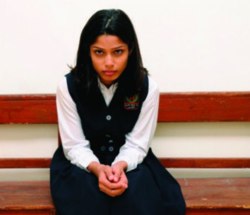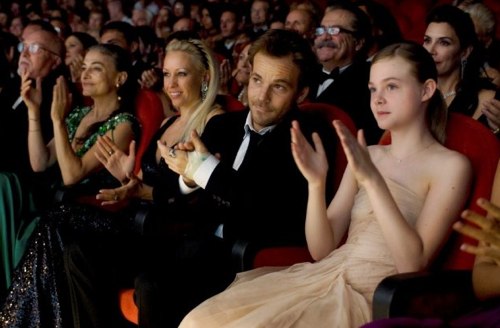Film festivals aren't always the glamorous affairs they're made out to be. Aside from the usual red carpet action, at most festivals it's unusual to see famous types out and about, potentially rubbing shoulders with mere mortals. And as much as I love the occasional random surprise celebrity sighting, that's fine with me. The downside to most festivals is that there's too much to see in an extremely short amount of time, and I need some real life banked around my movies.
The best non-celebrities on the Lido, in my estimation, can often be found walking along the stretch of sidewalk running parallel to the beach, in the vicinity of the majestic old Hotel Des Bains, which is where Thomas Mann set Death in Venice (and which appears to be undergoing some sort of renovation -- I fear it might be a condominium conversion). That's where, particularly around dusk, the elderly gents of the Lido can be found walking their (often) pot-bellied dogs, oblivious to the many journalists, critics and industry types rushing about, importantly, with their festival badges. These tend to be slow-moving guys, and slow-moving dogs, which is part of why I always like seeing them. They're a reminder that there is life outside listening to a bunch of journalists and critics nattering on about Black Swan, or whatever. Not that those discussions aren't sometimes fun -- but at festivals, where so many of our ilk congregate, it can be a pleasure to slip out of them temporarily. Bully for us, packing so many exquisite (or not) cinematic works into any given day! Somewhere out there, there's a dog waiting for his walk.
I wish I had a dog to walk right now, which would give me more time to think about Sofia Coppola's luminous, elusive Somewhere. Somewhere was the second movie of my day: The first was Julian Schnabel's Miral, a fictional (though somewhat fact-based) story set against the Israeli-Palestinian conflict. I had high hopes for Miral, since Schnabel's last feature, The Diving Bell and the Butterfly, was one of my favorite movies of the past decade. Miral is, paradoxically, both more modest and more ambitious than Diving Bell: Schnabel doesn't face the challenge of getting inside the mind of a man who's almost completely sealed off from the world; on the other hand, he's treading into extremely sticky political territory here, and the story he's trying to tell -- in which the lives of four women intertwine, over a span of some 45 years -- is technically more complicated.

Somewhere, on the other hand, is nothing but alive, to the point that just hours after watching it, I'm longing to see it again. Not much happens, really, in Somewhere. Stephen Dorff plays Johnny Marco, a movie star who's more raggedy handsome than ruggedly handsome: His face looks as if it hasn't seen a razor in a while, and his torso is dotted with possibly once-cool looking tattoos that now appear to have regret inked right into them. Johnny is holed up in a Los Angeles hotel, the Chateau Marmont; there's been a split from his wife -- we don't know how recently it happened, though the two appear to have been apart for a while. He and his ex have an 11-year-old daughter, Cleo (Elle Fanning), and it appears that Johnny spends time with her occasionally rather than regularly.
The movie opens with a Ferrari zooming 'round and 'round a dirt track. Coppola frames the shot so the oval ends of the track are lopped off -- the car leaves, re-enters and leaves the frame, so many times that we almost become jaded by the visual routine. It's the perfect setup for Johnny's going-nowhere life: He has a habit of hiring twin blonde pole dancers, who bring their equipment to his hotel room; as they perform for him, he lounges on the bed and watches them, wearing either a look of salacious boredom or boyish delight, depending on his mood. He goes to a party and picks up an attractive young woman -- then falls asleep in the middle of performing oral sex. He attends a press junket for his new movie (the brief press-conference sequence in this scene is one of the most painfully funny things I've seen this year, so spot-on that it hurts), and his co-star (played by Michelle Monaghan) glowers at him whenever the cameras aren't trained on them.
Obviously, something is very wrong with Johnny's life, and even if he could figure out what it was, he'd be too hapless and helpless to fix it: This is a guy who pays the people around him to do everything that needs doing. And yet when he spends a day with Cleo -- he brings her to an ice rink for her skating lesson and, at first, almost forgets to watch her as she executes her charming routine -- something in him begins to shake loose.
The whole of Somewhere is about that something shaking loose. And as I think about Somewhere now, I wonder: How can that even be a subject for a movie? Is there really enough there to fill a short, let alone a feature?
But that's Coppola's gift, the ability to build a movie around nothing more than a whisper (even, in the case of Lost in Translation, a literal whisper). Coppola may have the most delicate touch of any filmmaker currently working, and she has the most oblique sense of humor, too: At one point, Johnny is plunked into a chair and attended by a team of movie makeup people as they take a mold of his face. They slather his mug with goo that looks to be the consistency of rubbery egg whites; then they leave it to set. Coppola trains the camera on Johnny's face, which is no longer really a face: He's now a mashed-potato monster with no eyes or mouth (though the makeup artists have thoughtfully left him with handy nostril holes). The camera waits, and waits, as Johnny does. We can hear him breathing -- we can hear his boredom. It's the kind of living-in-the-moment sequence that Coppola does so well, a fillip that may seem extraneous but is actually an integral part of a supple, subtly joined whole.
Dorff is an underappreciated and underused actor; he was marvelous as Stu Sutcliffe in Iain Softley's 1994 Backbeat, about the early days of the Beatles, but he hasn't had many roles worthy of him in the years since. He's superb here: As a guy whose days as a young hunk are on the wane, Johnny is grabbing at everything and grasping nothing, and Dorff captures his flailing ambivalence perfectly.
And Fanning is simply lovely. In that skating scene, Cleo performs a series of moves that you can tell have been carefully rehearsed -- obviously, she's been working on this routine for months. And for that reason, she's graceful in a way that's alternately rehearsed and unstudied. With her coltish legs and half-willowy, half-gangly arms, she's in that in-between season, a silverleaf moment that will be over in a flash. Coppola captures that moment as if it were Jules Verne's (and Eric Rohmer's) green ray, that rare and fleeting sliver of light shooting from earth to sky at sunset. In life, that moment is over even before you know it's begun. Coppola's gift is the ability to stop time, ever so briefly, so we can get a better look.
